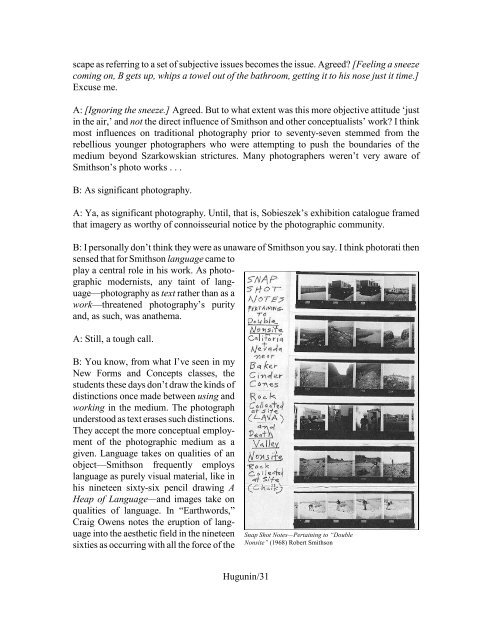It's Art, But Is It Photography? Robert Smithson's - Uturn.org
It's Art, But Is It Photography? Robert Smithson's - Uturn.org
It's Art, But Is It Photography? Robert Smithson's - Uturn.org
Create successful ePaper yourself
Turn your PDF publications into a flip-book with our unique Google optimized e-Paper software.
scape as referring to a set of subjective issues becomes the issue. Agreed? [Feeling a sneeze<br />
coming on, B gets up, whips a towel out of the bathroom, getting it to his nose just it time.]<br />
Excuse me.<br />
A: [Ignoring the sneeze.] Agreed. <strong>But</strong> to what extent was this more objective attitude ‘just<br />
in the air,’ and not the direct influence of Smithson and other conceptualists’ work? I think<br />
most influences on traditional photography prior to seventy-seven stemmed from the<br />
rebellious younger photographers who were attempting to push the boundaries of the<br />
medium beyond Szarkowskian strictures. Many photographers weren’t very aware of<br />
Smithson’s photo works . . .<br />
B: As significant photography.<br />
A: Ya, as significant photography. Until, that is, Sobieszek’s exhibition catalogue framed<br />
that imagery as worthy of connoisseurial notice by the photographic community.<br />
B: I personally don’t think they were as unaware of Smithson you say. I think photorati then<br />
sensed that for Smithson language came to<br />
play a central role in his work. As photographic<br />
modernists, any taint of language—photography<br />
as text rather than as a<br />
work—threatened photography’s purity<br />
and, as such, was anathema.<br />
A: Still, a tough call.<br />
B: You know, from what I’ve seen in my<br />
New Forms and Concepts classes, the<br />
students these days don’t draw the kinds of<br />
distinctions once made between using and<br />
working in the medium. The photograph<br />
understood as text erases such distinctions.<br />
They accept the more conceptual employment<br />
of the photographic medium as a<br />
given. Language takes on qualities of an<br />
object—Smithson frequently employs<br />
language as purely visual material, like in<br />
his nineteen sixty-six pencil drawing A<br />
Heap of Language—and images take on<br />
qualities of language. In “Earthwords,”<br />
Craig Owens notes the eruption of language<br />
into the aesthetic field in the nineteen<br />
sixties as occurring with all the force of the<br />
Snap Shot Notes—Pertaining to “Double<br />
Nonsite” (1968) <strong>Robert</strong> Smithson<br />
Hugunin/31


